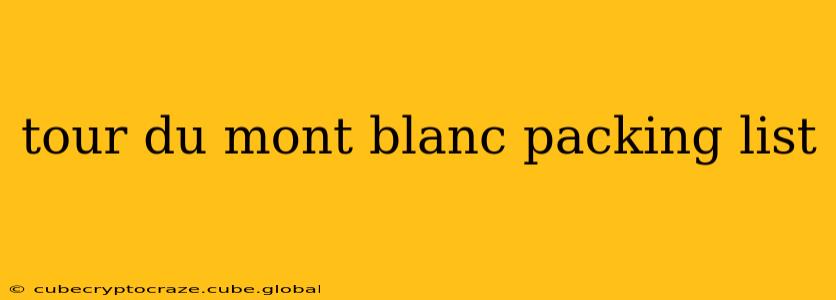The Tour du Mont Blanc (TMB) is an iconic trek, offering breathtaking views and challenging trails. Proper preparation is key to a successful and enjoyable journey. This comprehensive packing list covers everything you'll need, categorized for easy packing and reference. Remember, this is a guideline – adjust it based on your personal needs, the time of year, and the specific route you're taking.
Clothing: Layering is Key
The weather in the Alps can change rapidly. Layering allows you to adapt to fluctuating temperatures and conditions.
- Base Layers (3-4 sets): Merino wool or synthetic materials wick away moisture, keeping you dry and comfortable. Avoid cotton.
- Mid Layers (2-3): Fleece jacket or lightweight down jacket for insulation.
- Outer Shell Jacket: Waterproof and windproof jacket is crucial for protection against rain and wind.
- Hiking Trousers (2 pairs): Quick-drying, durable trousers are ideal. Consider convertible trousers for flexibility.
- Shorts (optional): For warmer days or evenings at the huts.
- Hiking Socks (4-5 pairs): Merino wool or synthetic hiking socks to prevent blisters.
- Underwear (7 pairs): Merino wool or synthetic materials.
- Warm Hat: Protects your head from the cold.
- Gloves or Mitts: Essential for cooler evenings and higher altitudes.
- Sun Hat: Protection from the sun's rays.
- Buff or Neck Gaiter: Versatile for sun protection, warmth, or dust protection.
Footwear & Accessories
- Hiking Boots: Well-broken-in, waterproof hiking boots are essential. Choose boots that provide good ankle support.
- Camp/Trail Shoes: A lighter pair of shoes for relaxing at the huts or around town.
- Trekking Poles (highly recommended): Provide stability and reduce strain on your knees and ankles.
- Backpack (50-70 liters): A comfortable backpack that fits your torso length is crucial.
- Dry Bags: Protect your electronics and other sensitive items from rain and sweat.
- Headlamp or Flashlight: Essential for navigating in the dark.
- Sunglasses: Protect your eyes from the sun's glare.
- Sunscreen: High SPF sunscreen is essential, even on cloudy days.
- Insect repellent: Protect yourself from mosquitoes and other insects.
Navigation & Communication
- Map and Compass: Learn how to use them before your trek!
- GPS Device or Smartphone with offline maps: A backup navigation system.
- Power Bank: To charge your electronic devices.
- First-Aid Kit: Include blister treatment, pain relievers, antiseptic wipes, etc.
- Whistle: For signaling in case of an emergency.
Other Essentials
- Toiletries: Travel-sized toiletries to minimize weight and space.
- Toiletries Bag: Waterproof or easily cleanable bag to keep your toiletries organized.
- Water Bottles or Hydration Reservoir (at least 2 liters capacity): Staying hydrated is critical.
- Water Filter or Purification Tablets: Essential for safe drinking water.
- Snacks: High-energy snacks like energy bars, nuts, and dried fruit.
- Quick-drying towel: A lightweight microfiber towel is perfect for backpacking.
- Sleeping Bag Liner (optional): Adds extra warmth and hygiene to your sleeping bag.
- Ear Plugs: Useful for sleeping in mountain huts.
- Eye Mask: Blocks out light for better sleep.
- Passport, Visa (if necessary), Insurance Information: Carry copies in a waterproof bag and leave a copy with someone at home.
- Credit Cards and Cash (Euros): Many huts only accept cash.
Frequently Asked Questions (FAQs)
What type of sleeping bag do I need for the TMB?
The temperature rating of your sleeping bag should depend on the time of year you are trekking. For summer, a 0°C to 5°C bag is usually sufficient, but for shoulder seasons, a lower temperature rating is advisable.
Do I need trekking poles for the TMB?
Trekking poles are highly recommended, particularly for the more challenging sections of the trail. They offer stability, reduce strain on your joints, and help with ascents and descents.
How much water should I carry?
Carry at least 2 liters of water, and refill whenever possible. Water sources are generally available, but not always consistently reliable, so it's crucial to be prepared.
What kind of backpack should I use?
A 50-70 liter backpack is generally recommended. Choose a pack that is comfortable and fits your torso length properly for better support and weight distribution.
What should I do about laundry during the TMB?
Most mountain huts offer basic laundry facilities, either a washing machine or a sink. However, washing clothes by hand is often preferable and faster. Quick drying fabrics are your best friend!
Remember to check the weather forecast before you go and adjust your packing list accordingly. Enjoy your unforgettable Tour du Mont Blanc!
